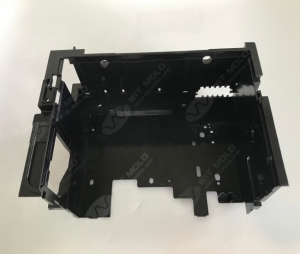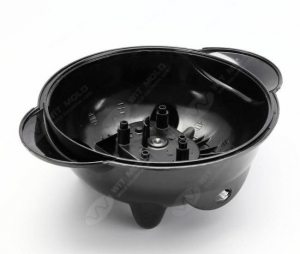In today’s manufacturing environment, plastics are used to manufacture a variety of items. Each application requires a special manufacturing process, which can shape parts according to their specifications. If you are making plastic parts, the first thing you need to determine is the type of molding that is best suited to your particular application.At WIT MOLD,We focus on custom plastic molding. This paper briefly summarizes five different types, their advantages and applications.

1>Blow molding – suitable for hollow objects, such as bottles
This process follows the basic steps in glass blowing. The parison (heated plastic block, usually pipe) is inflated by air. The air pushes the plastic against the mold to form the desired shape. After cooling, the plastic is ejected.
The blow molding process aims to produce large quantities of integrated hollow objects. If you need to make a lot of bottles, this is the process for you. Blow molding can produce very uniform thin-walled containers. Moreover, it can do this very economically.
2>Extrusion molding – suitable for long hollow molding applications, such as pipes, pipes and straws
Although other forms of molding use extrusion to put plastic resin into the mold, this process extrudes the molten plastic directly into the mold. The shape of the mold, not the mold, determines the shape of the final product.
Extrusion molding involves forcing molten plastic through a mold to form a shape with a fixed cross-section. This is an effective way to produce multiple shapes. Since plastics are melted from solid form and then re cured, only thermoplastics can be extruded. The extruded “pipe” can be cut or rolled up for shipment after cooling.
3>Injection molding – suitable for high quality and mass parts manufacturing
Injection molding is by far the most widely used of all injection molding technologies. The presses used in this process vary in size and are rated according to pressure or tonnage. Larger machines can inject auto parts. Smaller machines can produce very accurate plastic parts for surgery. In addition, many types of plastic resins and additives can be used in the injection molding process, which adds flexibility to designers and engineers.
The process itself is quite simple; However, there are many enhancement and customization technologies available to produce the required finishes and structures. Injection molds are usually made of steel and contain cavities for forming parts. Molten plastic is injected into the mold to fill the cavity. The mold cools and the parts are ejected through pins. This process is similar to a jelly mold, which is filled and then cooled to make the final product.
This method has high cost of mold making; However, the cost per part is very economical. Low part costs and resin and surface treatment options have contributed to the popularity of injection molding in today’s manufacturing field.
4>Compression molding – suitable for large objects, such as automobile parts
The name of this forming method says everything. The heated plastic material is put into the heated mold and then compressed into shape. Plastics can be in bulk, but usually in sheets. The heating process, called curing, ensures that the final part remains intact. As with other forming methods, once the part is formed, it is removed from the mold. If sheet plastic material is used, trim the material in the mold before taking out the part.
This molding method is very suitable for high-strength compounds, such as thermosetting resins, as well as glass fibers and reinforced plastics. The excellent strength characteristics of the materials used in compression molding make it a valuable process in the automotive industry.
5>Rotomolding – suitable for large, hollow and integrated parts
This process uses high temperature and rotary motion to coat the interior of the die and form parts. The continuous rotation of the die will produce centrifugal force, so as to form a product with uniform wall. Because it is very suitable for large hollow containers, such as cans, it is not a fast-moving process. However, this is a very economical process for specific applications and is cheaper than other types of molding. This process wastes few materials, and the excess materials can usually be reused, making it an economic and environmentally friendly manufacturing process.

Each type of molding has its advantages and disadvantages. Designers and engineers need to understand these differences and available production options, and there are always many ways to make the final solution.WIT MOLD has become one of the best molds in the industry because we combine the essence of the latest technology with proven traditional methods.
With an expert team composed of experienced and knowledgeable experts, we are able to complete custom orders for Custom Plastic Molds and parts that may exceed the capabilities of our competitors. We are also unremittingly committed to improving customer satisfaction, which includes providing comprehensive end-to-end quality assurance for every product we produce.

没有评论:
发表评论